Report on Business Operations and Leadership: Tesco Case Study
VerifiedAdded on 2020/12/29
|13
|3007
|261
Report
AI Summary
This report provides a comprehensive analysis of business operations, using Tesco as a case study. It covers various aspects, including different types of organizations in the UK, organizational structures, and the impact of the business environment. The report delves into the importance of accounting, the functions of the HR department, and key features of employment legislation. It also examines the interpretation of profit and loss accounts, the role of team leaders and team members, stages of team development, motivation theories, and leadership styles. Furthermore, the report highlights the impact of customer service on business success and the benefits of customer profiling. The content is a student contribution, and Desklib provides similar resources for students, including past papers and solved assignments.
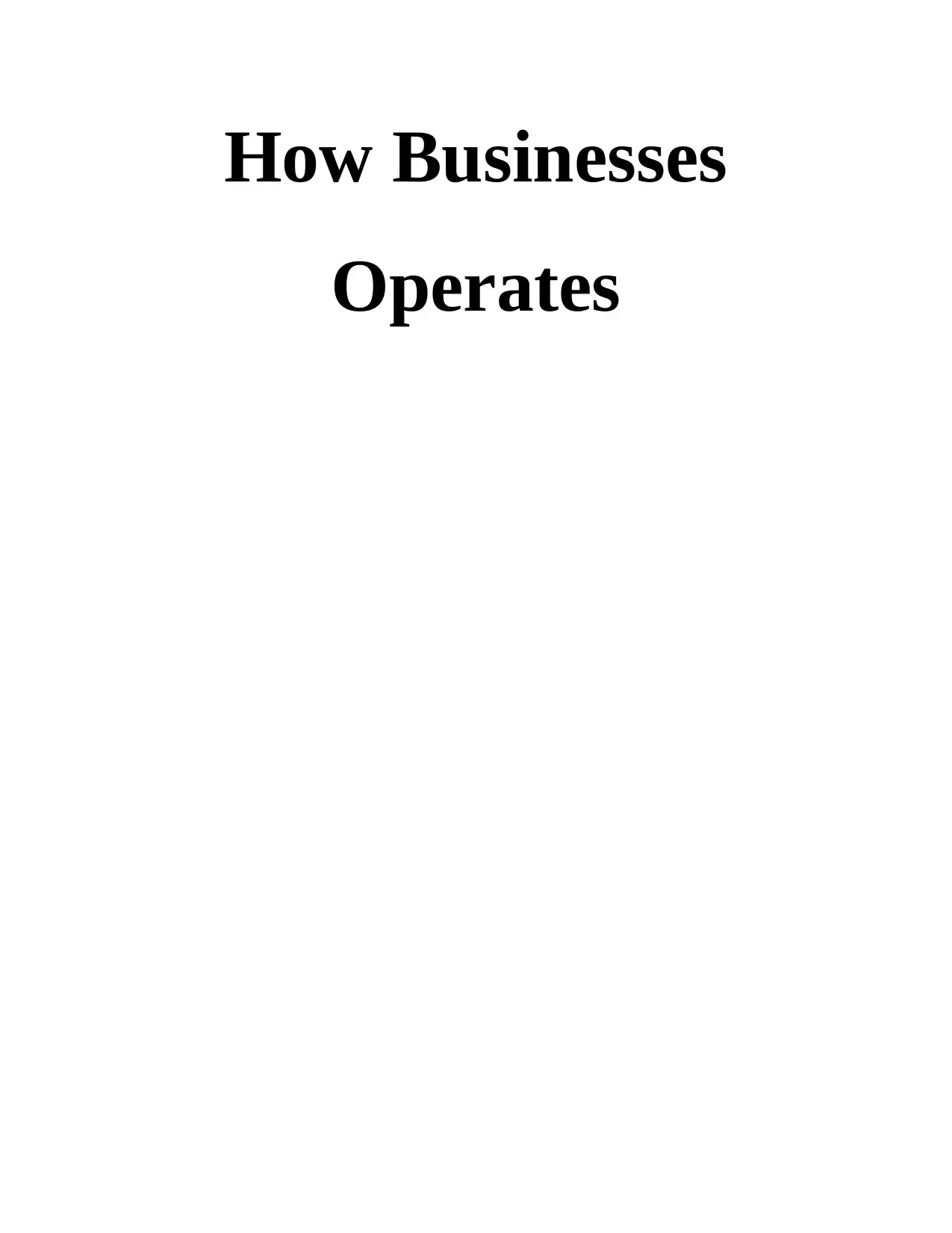
How Businesses
Operates
Operates
Paraphrase This Document
Need a fresh take? Get an instant paraphrase of this document with our AI Paraphraser
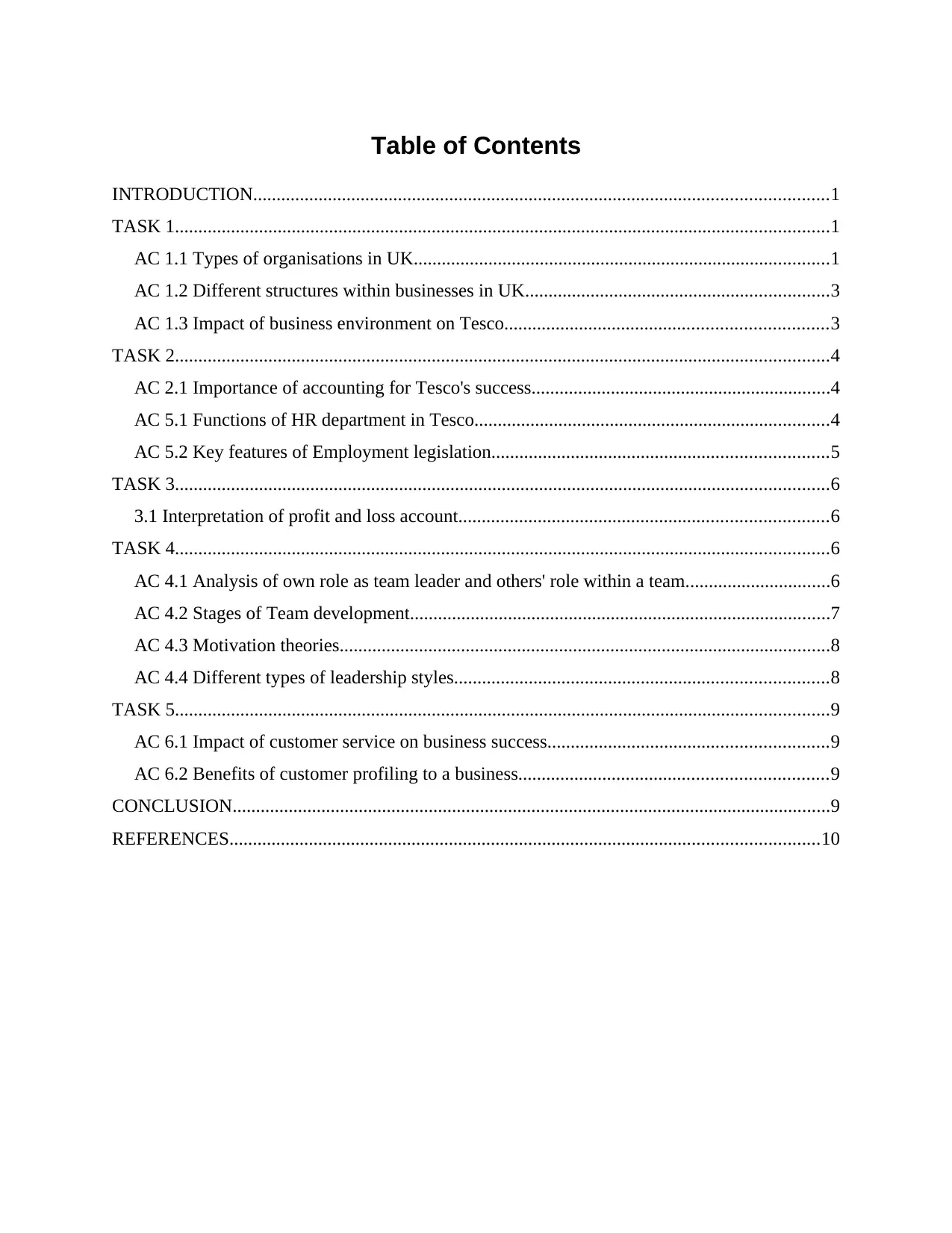
Table of Contents
INTRODUCTION...........................................................................................................................1
TASK 1............................................................................................................................................1
AC 1.1 Types of organisations in UK.........................................................................................1
AC 1.2 Different structures within businesses in UK.................................................................3
AC 1.3 Impact of business environment on Tesco.....................................................................3
TASK 2............................................................................................................................................4
AC 2.1 Importance of accounting for Tesco's success................................................................4
AC 5.1 Functions of HR department in Tesco............................................................................4
AC 5.2 Key features of Employment legislation........................................................................5
TASK 3............................................................................................................................................6
3.1 Interpretation of profit and loss account...............................................................................6
TASK 4............................................................................................................................................6
AC 4.1 Analysis of own role as team leader and others' role within a team...............................6
AC 4.2 Stages of Team development..........................................................................................7
AC 4.3 Motivation theories.........................................................................................................8
AC 4.4 Different types of leadership styles................................................................................8
TASK 5............................................................................................................................................9
AC 6.1 Impact of customer service on business success............................................................9
AC 6.2 Benefits of customer profiling to a business..................................................................9
CONCLUSION................................................................................................................................9
REFERENCES..............................................................................................................................10
INTRODUCTION...........................................................................................................................1
TASK 1............................................................................................................................................1
AC 1.1 Types of organisations in UK.........................................................................................1
AC 1.2 Different structures within businesses in UK.................................................................3
AC 1.3 Impact of business environment on Tesco.....................................................................3
TASK 2............................................................................................................................................4
AC 2.1 Importance of accounting for Tesco's success................................................................4
AC 5.1 Functions of HR department in Tesco............................................................................4
AC 5.2 Key features of Employment legislation........................................................................5
TASK 3............................................................................................................................................6
3.1 Interpretation of profit and loss account...............................................................................6
TASK 4............................................................................................................................................6
AC 4.1 Analysis of own role as team leader and others' role within a team...............................6
AC 4.2 Stages of Team development..........................................................................................7
AC 4.3 Motivation theories.........................................................................................................8
AC 4.4 Different types of leadership styles................................................................................8
TASK 5............................................................................................................................................9
AC 6.1 Impact of customer service on business success............................................................9
AC 6.2 Benefits of customer profiling to a business..................................................................9
CONCLUSION................................................................................................................................9
REFERENCES..............................................................................................................................10
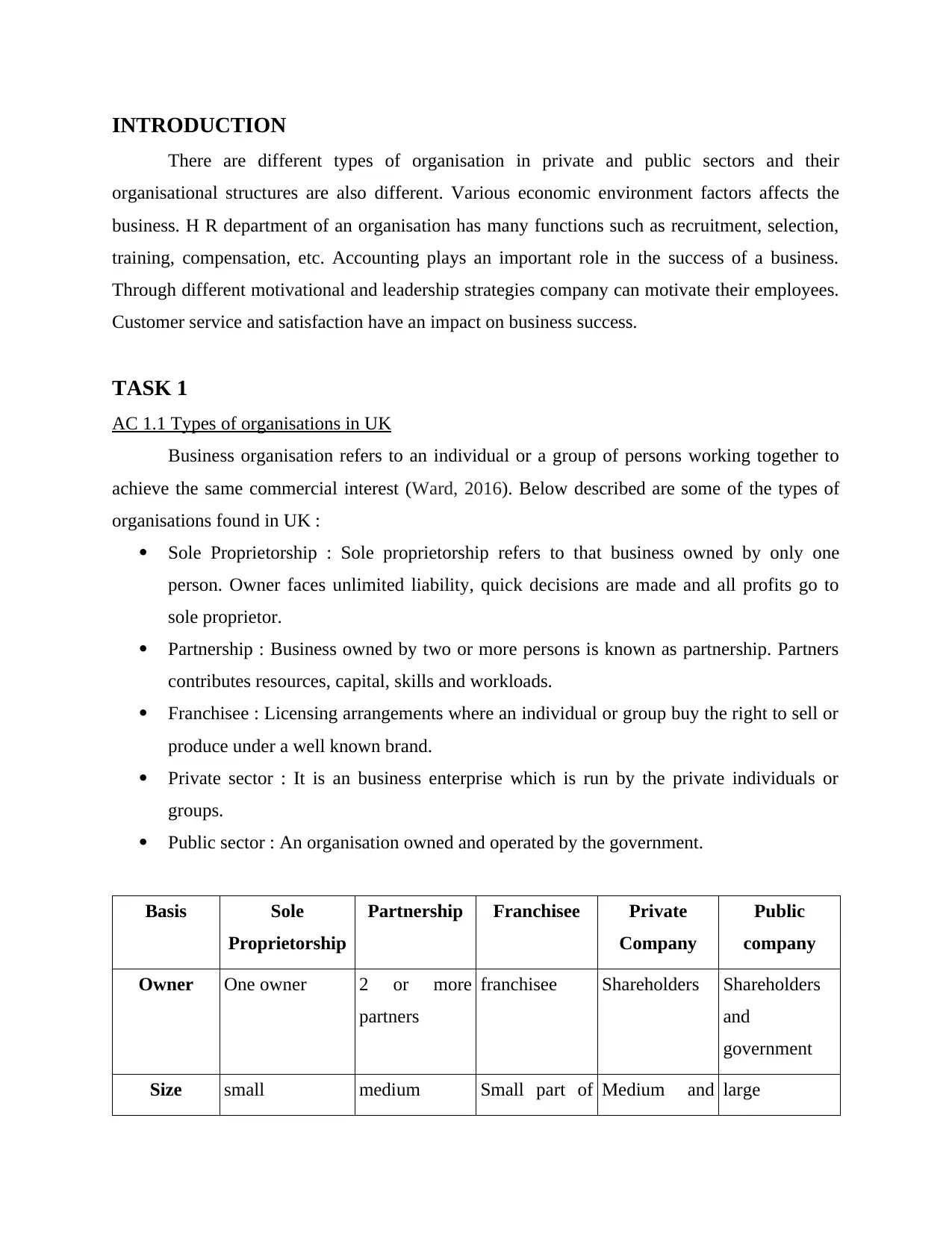
INTRODUCTION
There are different types of organisation in private and public sectors and their
organisational structures are also different. Various economic environment factors affects the
business. H R department of an organisation has many functions such as recruitment, selection,
training, compensation, etc. Accounting plays an important role in the success of a business.
Through different motivational and leadership strategies company can motivate their employees.
Customer service and satisfaction have an impact on business success.
TASK 1
AC 1.1 Types of organisations in UK
Business organisation refers to an individual or a group of persons working together to
achieve the same commercial interest (Ward, 2016). Below described are some of the types of
organisations found in UK :
Sole Proprietorship : Sole proprietorship refers to that business owned by only one
person. Owner faces unlimited liability, quick decisions are made and all profits go to
sole proprietor.
Partnership : Business owned by two or more persons is known as partnership. Partners
contributes resources, capital, skills and workloads.
Franchisee : Licensing arrangements where an individual or group buy the right to sell or
produce under a well known brand.
Private sector : It is an business enterprise which is run by the private individuals or
groups.
Public sector : An organisation owned and operated by the government.
Basis Sole
Proprietorship
Partnership Franchisee Private
Company
Public
company
Owner One owner 2 or more
partners
franchisee Shareholders Shareholders
and
government
Size small medium Small part of Medium and large
There are different types of organisation in private and public sectors and their
organisational structures are also different. Various economic environment factors affects the
business. H R department of an organisation has many functions such as recruitment, selection,
training, compensation, etc. Accounting plays an important role in the success of a business.
Through different motivational and leadership strategies company can motivate their employees.
Customer service and satisfaction have an impact on business success.
TASK 1
AC 1.1 Types of organisations in UK
Business organisation refers to an individual or a group of persons working together to
achieve the same commercial interest (Ward, 2016). Below described are some of the types of
organisations found in UK :
Sole Proprietorship : Sole proprietorship refers to that business owned by only one
person. Owner faces unlimited liability, quick decisions are made and all profits go to
sole proprietor.
Partnership : Business owned by two or more persons is known as partnership. Partners
contributes resources, capital, skills and workloads.
Franchisee : Licensing arrangements where an individual or group buy the right to sell or
produce under a well known brand.
Private sector : It is an business enterprise which is run by the private individuals or
groups.
Public sector : An organisation owned and operated by the government.
Basis Sole
Proprietorship
Partnership Franchisee Private
Company
Public
company
Owner One owner 2 or more
partners
franchisee Shareholders Shareholders
and
government
Size small medium Small part of Medium and large
⊘ This is a preview!⊘
Do you want full access?
Subscribe today to unlock all pages.

Trusted by 1+ million students worldwide
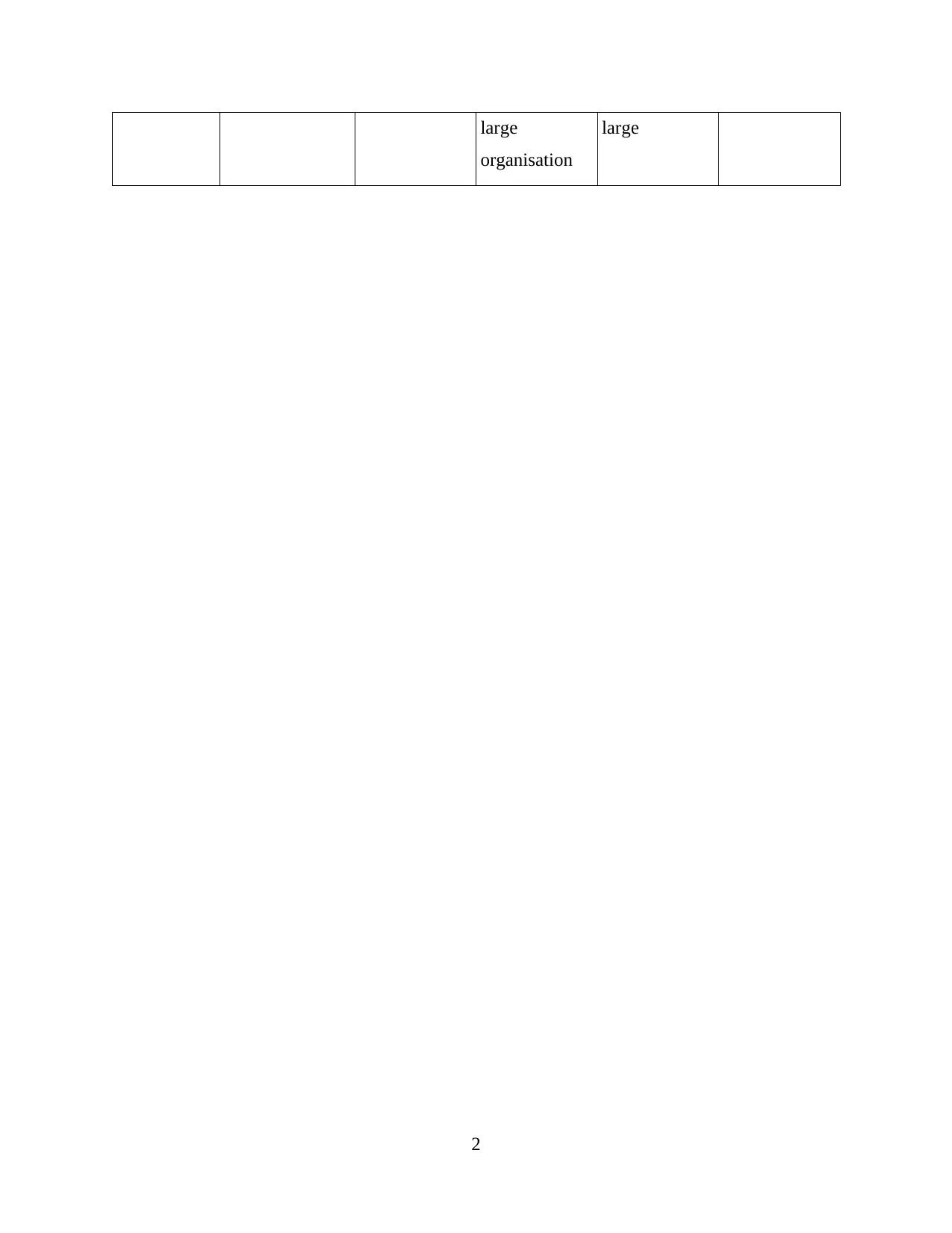
large
organisation
large
2
organisation
large
2
Paraphrase This Document
Need a fresh take? Get an instant paraphrase of this document with our AI Paraphraser
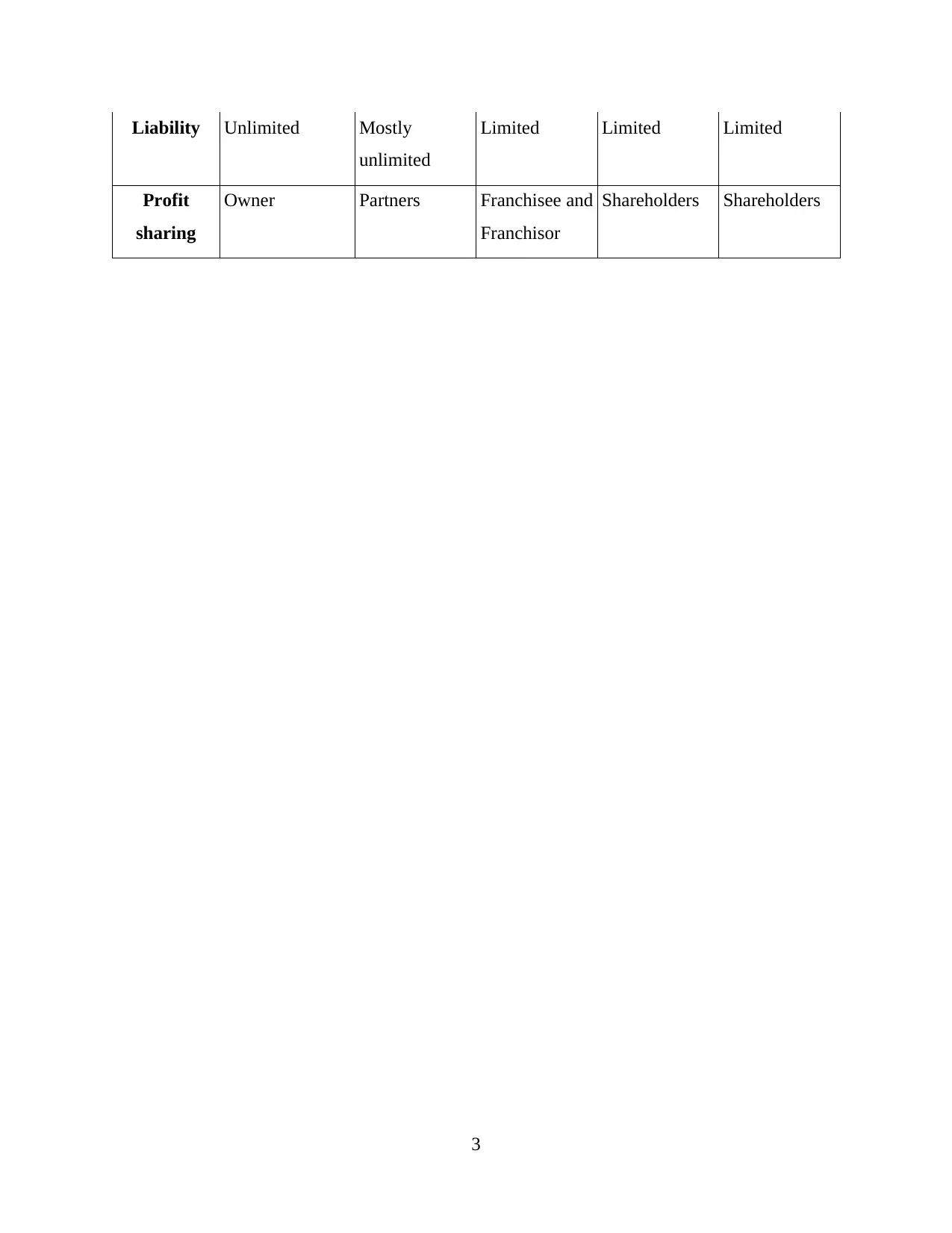
Liability Unlimited Mostly
unlimited
Limited Limited Limited
Profit
sharing
Owner Partners Franchisee and
Franchisor
Shareholders Shareholders
3
unlimited
Limited Limited Limited
Profit
sharing
Owner Partners Franchisee and
Franchisor
Shareholders Shareholders
3
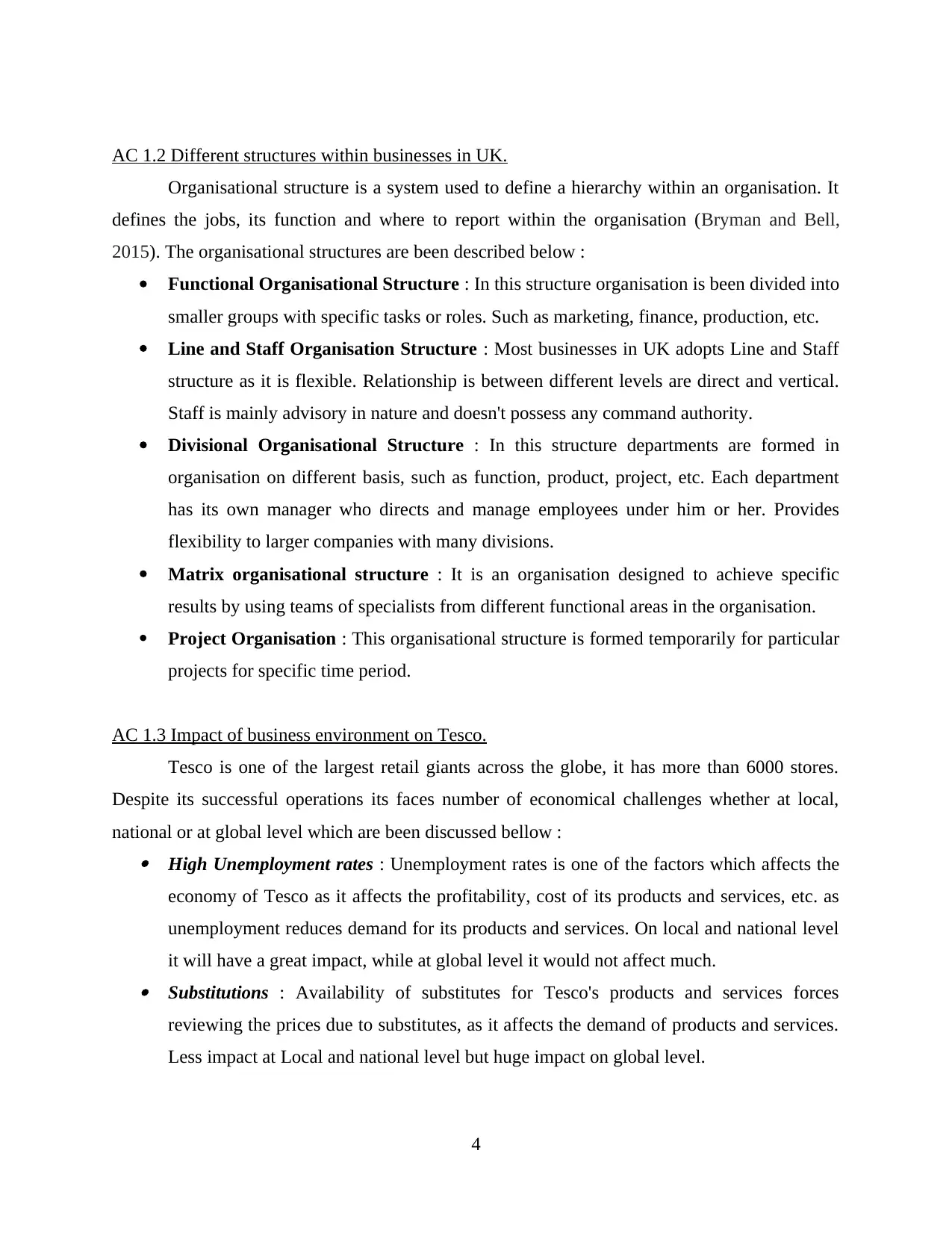
AC 1.2 Different structures within businesses in UK.
Organisational structure is a system used to define a hierarchy within an organisation. It
defines the jobs, its function and where to report within the organisation (Bryman and Bell,
2015). The organisational structures are been described below :
Functional Organisational Structure : In this structure organisation is been divided into
smaller groups with specific tasks or roles. Such as marketing, finance, production, etc.
Line and Staff Organisation Structure : Most businesses in UK adopts Line and Staff
structure as it is flexible. Relationship is between different levels are direct and vertical.
Staff is mainly advisory in nature and doesn't possess any command authority.
Divisional Organisational Structure : In this structure departments are formed in
organisation on different basis, such as function, product, project, etc. Each department
has its own manager who directs and manage employees under him or her. Provides
flexibility to larger companies with many divisions.
Matrix organisational structure : It is an organisation designed to achieve specific
results by using teams of specialists from different functional areas in the organisation.
Project Organisation : This organisational structure is formed temporarily for particular
projects for specific time period.
AC 1.3 Impact of business environment on Tesco.
Tesco is one of the largest retail giants across the globe, it has more than 6000 stores.
Despite its successful operations its faces number of economical challenges whether at local,
national or at global level which are been discussed bellow : High Unemployment rates : Unemployment rates is one of the factors which affects the
economy of Tesco as it affects the profitability, cost of its products and services, etc. as
unemployment reduces demand for its products and services. On local and national level
it will have a great impact, while at global level it would not affect much. Substitutions : Availability of substitutes for Tesco's products and services forces
reviewing the prices due to substitutes, as it affects the demand of products and services.
Less impact at Local and national level but huge impact on global level.
4
Organisational structure is a system used to define a hierarchy within an organisation. It
defines the jobs, its function and where to report within the organisation (Bryman and Bell,
2015). The organisational structures are been described below :
Functional Organisational Structure : In this structure organisation is been divided into
smaller groups with specific tasks or roles. Such as marketing, finance, production, etc.
Line and Staff Organisation Structure : Most businesses in UK adopts Line and Staff
structure as it is flexible. Relationship is between different levels are direct and vertical.
Staff is mainly advisory in nature and doesn't possess any command authority.
Divisional Organisational Structure : In this structure departments are formed in
organisation on different basis, such as function, product, project, etc. Each department
has its own manager who directs and manage employees under him or her. Provides
flexibility to larger companies with many divisions.
Matrix organisational structure : It is an organisation designed to achieve specific
results by using teams of specialists from different functional areas in the organisation.
Project Organisation : This organisational structure is formed temporarily for particular
projects for specific time period.
AC 1.3 Impact of business environment on Tesco.
Tesco is one of the largest retail giants across the globe, it has more than 6000 stores.
Despite its successful operations its faces number of economical challenges whether at local,
national or at global level which are been discussed bellow : High Unemployment rates : Unemployment rates is one of the factors which affects the
economy of Tesco as it affects the profitability, cost of its products and services, etc. as
unemployment reduces demand for its products and services. On local and national level
it will have a great impact, while at global level it would not affect much. Substitutions : Availability of substitutes for Tesco's products and services forces
reviewing the prices due to substitutes, as it affects the demand of products and services.
Less impact at Local and national level but huge impact on global level.
4
⊘ This is a preview!⊘
Do you want full access?
Subscribe today to unlock all pages.

Trusted by 1+ million students worldwide
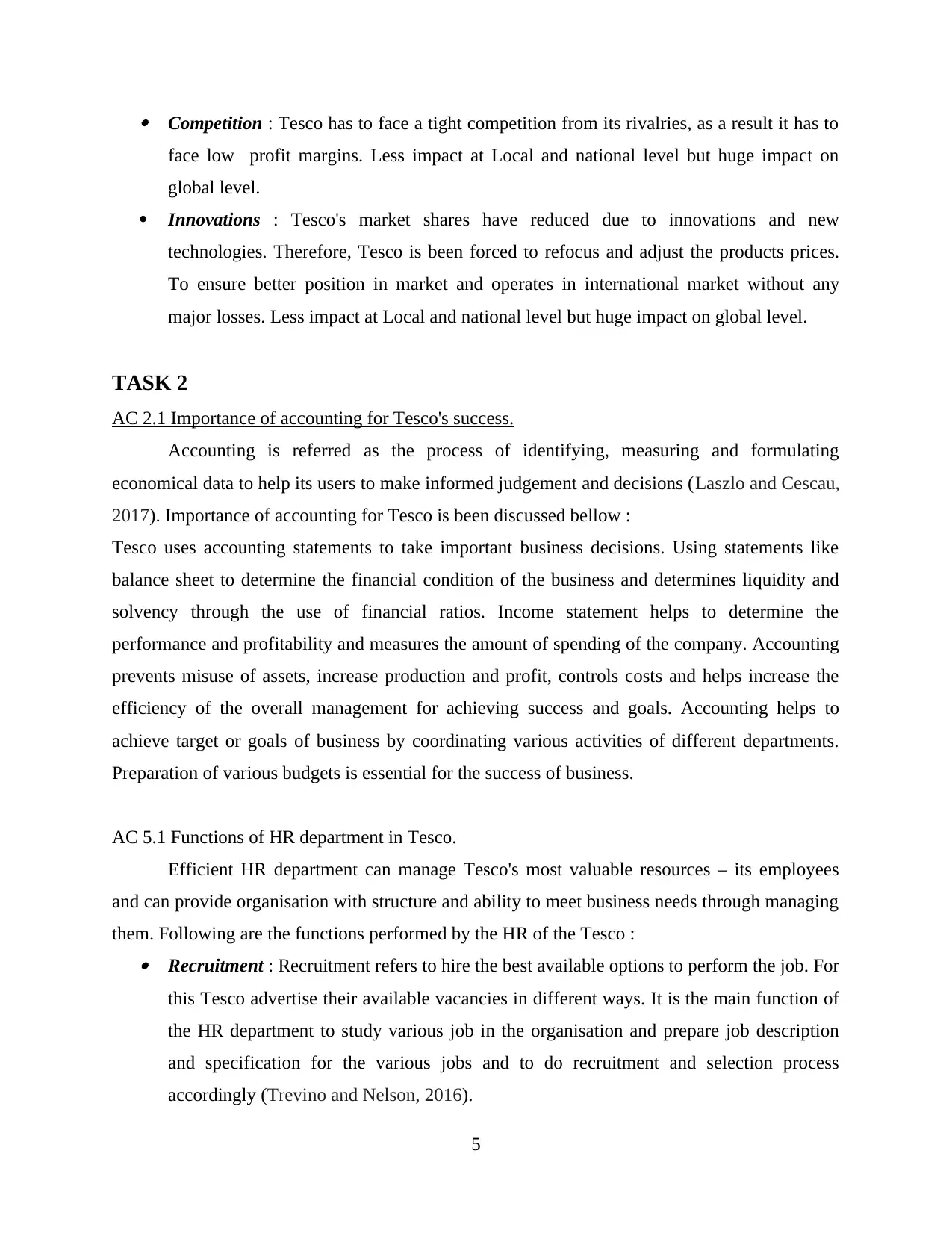
Competition : Tesco has to face a tight competition from its rivalries, as a result it has to
face low profit margins. Less impact at Local and national level but huge impact on
global level.
Innovations : Tesco's market shares have reduced due to innovations and new
technologies. Therefore, Tesco is been forced to refocus and adjust the products prices.
To ensure better position in market and operates in international market without any
major losses. Less impact at Local and national level but huge impact on global level.
TASK 2
AC 2.1 Importance of accounting for Tesco's success.
Accounting is referred as the process of identifying, measuring and formulating
economical data to help its users to make informed judgement and decisions (Laszlo and Cescau,
2017). Importance of accounting for Tesco is been discussed bellow :
Tesco uses accounting statements to take important business decisions. Using statements like
balance sheet to determine the financial condition of the business and determines liquidity and
solvency through the use of financial ratios. Income statement helps to determine the
performance and profitability and measures the amount of spending of the company. Accounting
prevents misuse of assets, increase production and profit, controls costs and helps increase the
efficiency of the overall management for achieving success and goals. Accounting helps to
achieve target or goals of business by coordinating various activities of different departments.
Preparation of various budgets is essential for the success of business.
AC 5.1 Functions of HR department in Tesco.
Efficient HR department can manage Tesco's most valuable resources – its employees
and can provide organisation with structure and ability to meet business needs through managing
them. Following are the functions performed by the HR of the Tesco : Recruitment : Recruitment refers to hire the best available options to perform the job. For
this Tesco advertise their available vacancies in different ways. It is the main function of
the HR department to study various job in the organisation and prepare job description
and specification for the various jobs and to do recruitment and selection process
accordingly (Trevino and Nelson, 2016).
5
face low profit margins. Less impact at Local and national level but huge impact on
global level.
Innovations : Tesco's market shares have reduced due to innovations and new
technologies. Therefore, Tesco is been forced to refocus and adjust the products prices.
To ensure better position in market and operates in international market without any
major losses. Less impact at Local and national level but huge impact on global level.
TASK 2
AC 2.1 Importance of accounting for Tesco's success.
Accounting is referred as the process of identifying, measuring and formulating
economical data to help its users to make informed judgement and decisions (Laszlo and Cescau,
2017). Importance of accounting for Tesco is been discussed bellow :
Tesco uses accounting statements to take important business decisions. Using statements like
balance sheet to determine the financial condition of the business and determines liquidity and
solvency through the use of financial ratios. Income statement helps to determine the
performance and profitability and measures the amount of spending of the company. Accounting
prevents misuse of assets, increase production and profit, controls costs and helps increase the
efficiency of the overall management for achieving success and goals. Accounting helps to
achieve target or goals of business by coordinating various activities of different departments.
Preparation of various budgets is essential for the success of business.
AC 5.1 Functions of HR department in Tesco.
Efficient HR department can manage Tesco's most valuable resources – its employees
and can provide organisation with structure and ability to meet business needs through managing
them. Following are the functions performed by the HR of the Tesco : Recruitment : Recruitment refers to hire the best available options to perform the job. For
this Tesco advertise their available vacancies in different ways. It is the main function of
the HR department to study various job in the organisation and prepare job description
and specification for the various jobs and to do recruitment and selection process
accordingly (Trevino and Nelson, 2016).
5
Paraphrase This Document
Need a fresh take? Get an instant paraphrase of this document with our AI Paraphraser
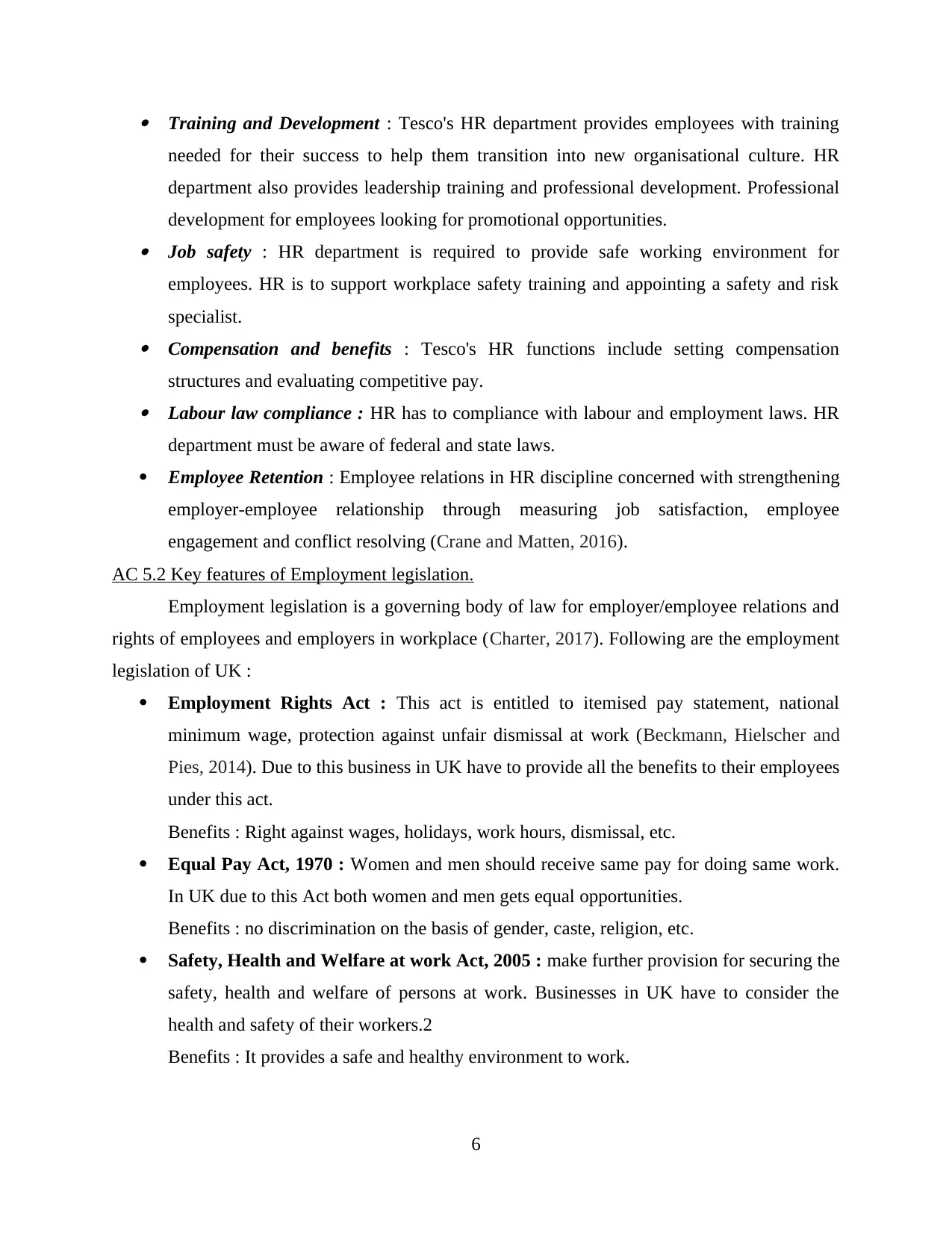
Training and Development : Tesco's HR department provides employees with training
needed for their success to help them transition into new organisational culture. HR
department also provides leadership training and professional development. Professional
development for employees looking for promotional opportunities. Job safety : HR department is required to provide safe working environment for
employees. HR is to support workplace safety training and appointing a safety and risk
specialist. Compensation and benefits : Tesco's HR functions include setting compensation
structures and evaluating competitive pay. Labour law compliance : HR has to compliance with labour and employment laws. HR
department must be aware of federal and state laws.
Employee Retention : Employee relations in HR discipline concerned with strengthening
employer-employee relationship through measuring job satisfaction, employee
engagement and conflict resolving (Crane and Matten, 2016).
AC 5.2 Key features of Employment legislation.
Employment legislation is a governing body of law for employer/employee relations and
rights of employees and employers in workplace (Charter, 2017). Following are the employment
legislation of UK :
Employment Rights Act : This act is entitled to itemised pay statement, national
minimum wage, protection against unfair dismissal at work (Beckmann, Hielscher and
Pies, 2014). Due to this business in UK have to provide all the benefits to their employees
under this act.
Benefits : Right against wages, holidays, work hours, dismissal, etc.
Equal Pay Act, 1970 : Women and men should receive same pay for doing same work.
In UK due to this Act both women and men gets equal opportunities.
Benefits : no discrimination on the basis of gender, caste, religion, etc.
Safety, Health and Welfare at work Act, 2005 : make further provision for securing the
safety, health and welfare of persons at work. Businesses in UK have to consider the
health and safety of their workers.2
Benefits : It provides a safe and healthy environment to work.
6
needed for their success to help them transition into new organisational culture. HR
department also provides leadership training and professional development. Professional
development for employees looking for promotional opportunities. Job safety : HR department is required to provide safe working environment for
employees. HR is to support workplace safety training and appointing a safety and risk
specialist. Compensation and benefits : Tesco's HR functions include setting compensation
structures and evaluating competitive pay. Labour law compliance : HR has to compliance with labour and employment laws. HR
department must be aware of federal and state laws.
Employee Retention : Employee relations in HR discipline concerned with strengthening
employer-employee relationship through measuring job satisfaction, employee
engagement and conflict resolving (Crane and Matten, 2016).
AC 5.2 Key features of Employment legislation.
Employment legislation is a governing body of law for employer/employee relations and
rights of employees and employers in workplace (Charter, 2017). Following are the employment
legislation of UK :
Employment Rights Act : This act is entitled to itemised pay statement, national
minimum wage, protection against unfair dismissal at work (Beckmann, Hielscher and
Pies, 2014). Due to this business in UK have to provide all the benefits to their employees
under this act.
Benefits : Right against wages, holidays, work hours, dismissal, etc.
Equal Pay Act, 1970 : Women and men should receive same pay for doing same work.
In UK due to this Act both women and men gets equal opportunities.
Benefits : no discrimination on the basis of gender, caste, religion, etc.
Safety, Health and Welfare at work Act, 2005 : make further provision for securing the
safety, health and welfare of persons at work. Businesses in UK have to consider the
health and safety of their workers.2
Benefits : It provides a safe and healthy environment to work.
6
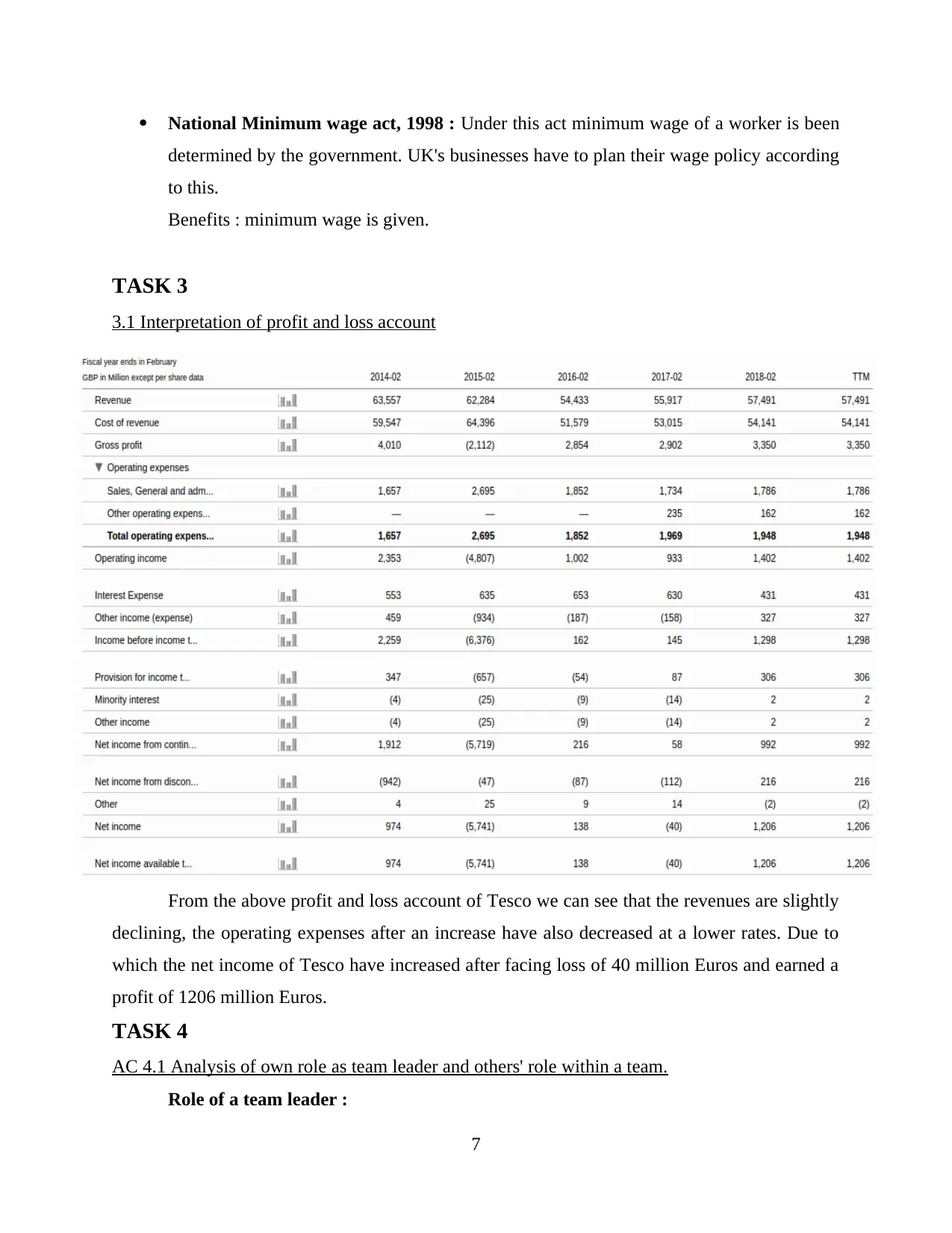
National Minimum wage act, 1998 : Under this act minimum wage of a worker is been
determined by the government. UK's businesses have to plan their wage policy according
to this.
Benefits : minimum wage is given.
TASK 3
3.1 Interpretation of profit and loss account
From the above profit and loss account of Tesco we can see that the revenues are slightly
declining, the operating expenses after an increase have also decreased at a lower rates. Due to
which the net income of Tesco have increased after facing loss of 40 million Euros and earned a
profit of 1206 million Euros.
TASK 4
AC 4.1 Analysis of own role as team leader and others' role within a team.
Role of a team leader :
7
determined by the government. UK's businesses have to plan their wage policy according
to this.
Benefits : minimum wage is given.
TASK 3
3.1 Interpretation of profit and loss account
From the above profit and loss account of Tesco we can see that the revenues are slightly
declining, the operating expenses after an increase have also decreased at a lower rates. Due to
which the net income of Tesco have increased after facing loss of 40 million Euros and earned a
profit of 1206 million Euros.
TASK 4
AC 4.1 Analysis of own role as team leader and others' role within a team.
Role of a team leader :
7
⊘ This is a preview!⊘
Do you want full access?
Subscribe today to unlock all pages.

Trusted by 1+ million students worldwide
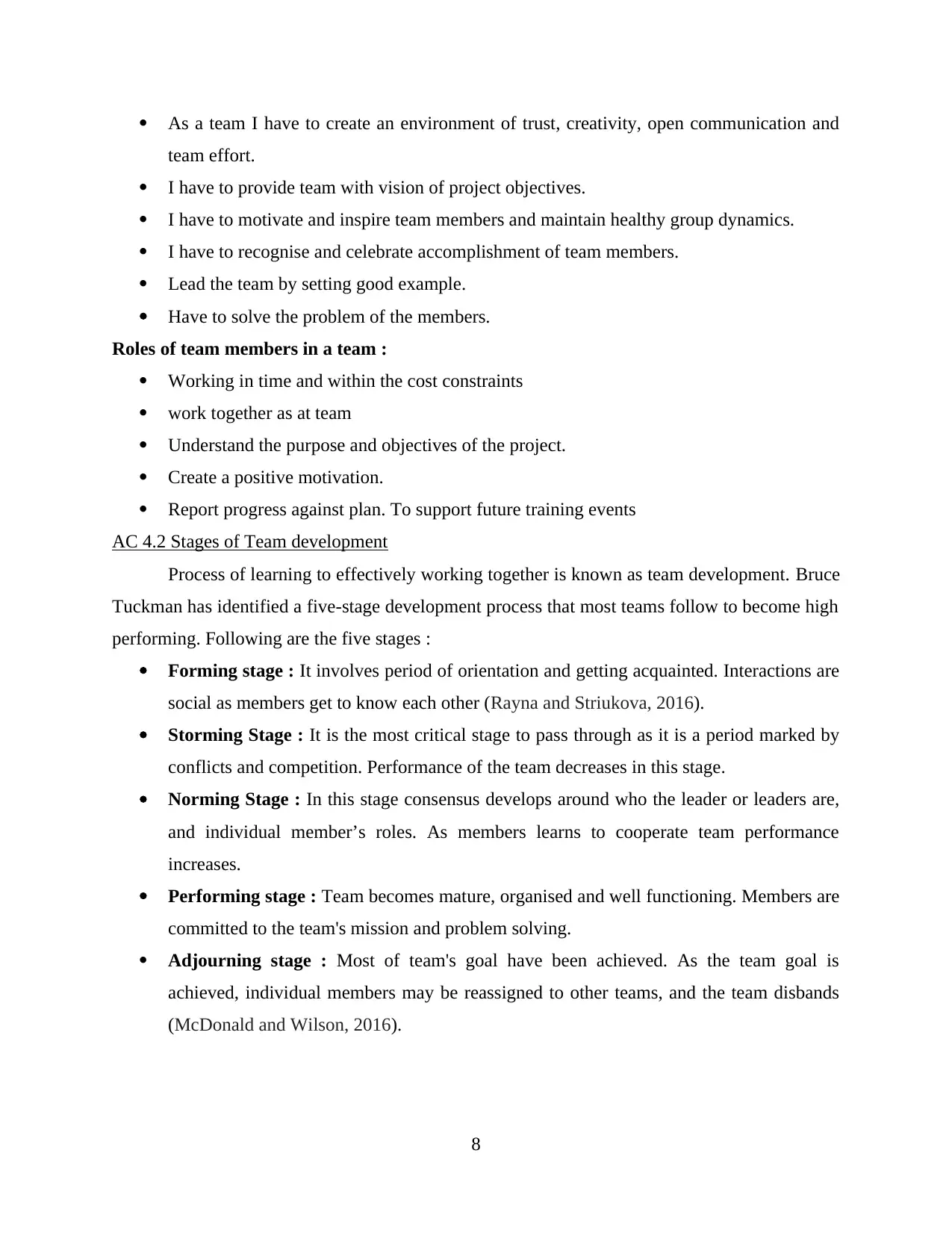
As a team I have to create an environment of trust, creativity, open communication and
team effort.
I have to provide team with vision of project objectives.
I have to motivate and inspire team members and maintain healthy group dynamics.
I have to recognise and celebrate accomplishment of team members.
Lead the team by setting good example.
Have to solve the problem of the members.
Roles of team members in a team :
Working in time and within the cost constraints
work together as at team
Understand the purpose and objectives of the project.
Create a positive motivation.
Report progress against plan. To support future training events
AC 4.2 Stages of Team development
Process of learning to effectively working together is known as team development. Bruce
Tuckman has identified a five-stage development process that most teams follow to become high
performing. Following are the five stages :
Forming stage : It involves period of orientation and getting acquainted. Interactions are
social as members get to know each other (Rayna and Striukova, 2016).
Storming Stage : It is the most critical stage to pass through as it is a period marked by
conflicts and competition. Performance of the team decreases in this stage.
Norming Stage : In this stage consensus develops around who the leader or leaders are,
and individual member’s roles. As members learns to cooperate team performance
increases.
Performing stage : Team becomes mature, organised and well functioning. Members are
committed to the team's mission and problem solving.
Adjourning stage : Most of team's goal have been achieved. As the team goal is
achieved, individual members may be reassigned to other teams, and the team disbands
(McDonald and Wilson, 2016).
8
team effort.
I have to provide team with vision of project objectives.
I have to motivate and inspire team members and maintain healthy group dynamics.
I have to recognise and celebrate accomplishment of team members.
Lead the team by setting good example.
Have to solve the problem of the members.
Roles of team members in a team :
Working in time and within the cost constraints
work together as at team
Understand the purpose and objectives of the project.
Create a positive motivation.
Report progress against plan. To support future training events
AC 4.2 Stages of Team development
Process of learning to effectively working together is known as team development. Bruce
Tuckman has identified a five-stage development process that most teams follow to become high
performing. Following are the five stages :
Forming stage : It involves period of orientation and getting acquainted. Interactions are
social as members get to know each other (Rayna and Striukova, 2016).
Storming Stage : It is the most critical stage to pass through as it is a period marked by
conflicts and competition. Performance of the team decreases in this stage.
Norming Stage : In this stage consensus develops around who the leader or leaders are,
and individual member’s roles. As members learns to cooperate team performance
increases.
Performing stage : Team becomes mature, organised and well functioning. Members are
committed to the team's mission and problem solving.
Adjourning stage : Most of team's goal have been achieved. As the team goal is
achieved, individual members may be reassigned to other teams, and the team disbands
(McDonald and Wilson, 2016).
8
Paraphrase This Document
Need a fresh take? Get an instant paraphrase of this document with our AI Paraphraser
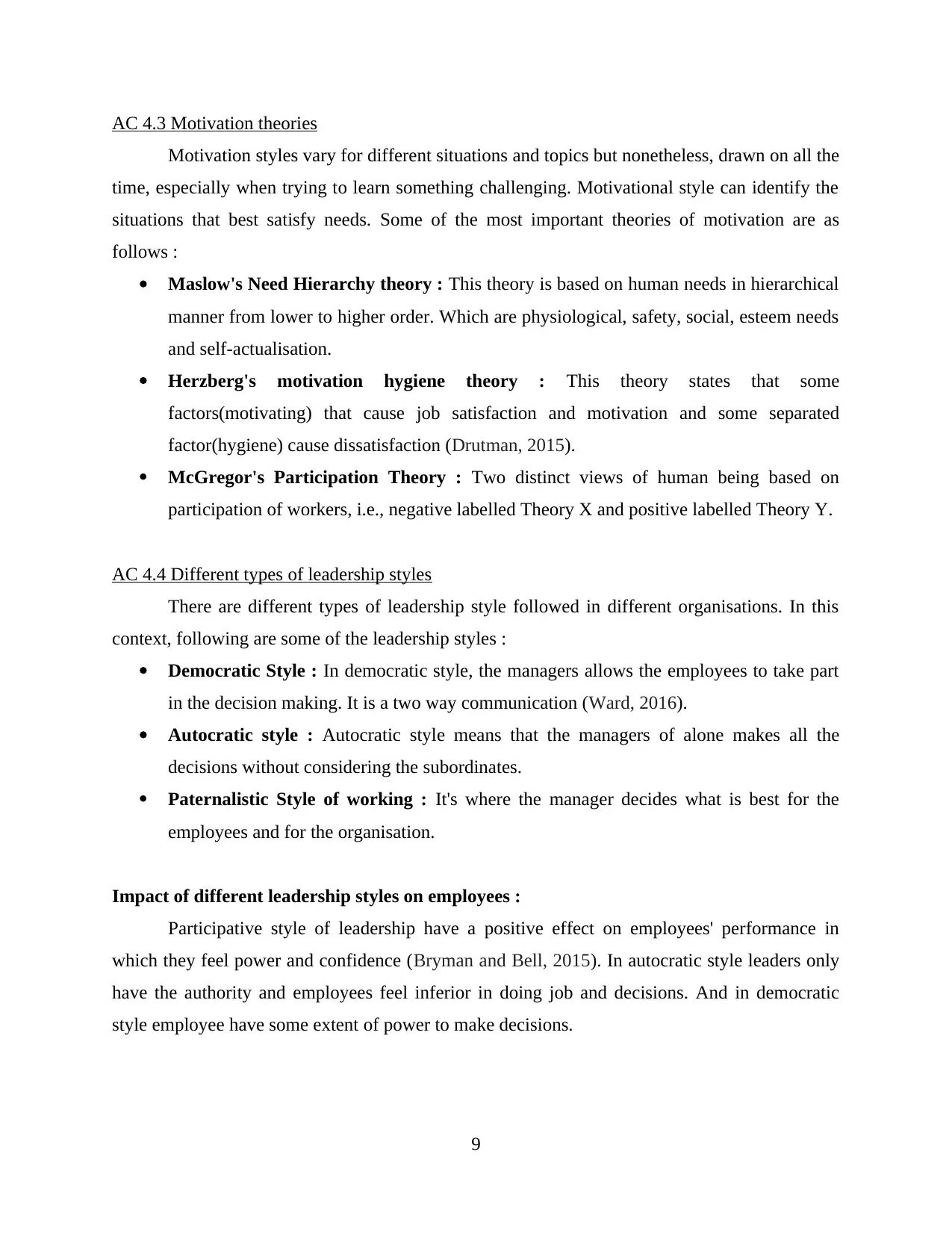
AC 4.3 Motivation theories
Motivation styles vary for different situations and topics but nonetheless, drawn on all the
time, especially when trying to learn something challenging. Motivational style can identify the
situations that best satisfy needs. Some of the most important theories of motivation are as
follows :
Maslow's Need Hierarchy theory : This theory is based on human needs in hierarchical
manner from lower to higher order. Which are physiological, safety, social, esteem needs
and self-actualisation.
Herzberg's motivation hygiene theory : This theory states that some
factors(motivating) that cause job satisfaction and motivation and some separated
factor(hygiene) cause dissatisfaction (Drutman, 2015).
McGregor's Participation Theory : Two distinct views of human being based on
participation of workers, i.e., negative labelled Theory X and positive labelled Theory Y.
AC 4.4 Different types of leadership styles
There are different types of leadership style followed in different organisations. In this
context, following are some of the leadership styles :
Democratic Style : In democratic style, the managers allows the employees to take part
in the decision making. It is a two way communication (Ward, 2016).
Autocratic style : Autocratic style means that the managers of alone makes all the
decisions without considering the subordinates.
Paternalistic Style of working : It's where the manager decides what is best for the
employees and for the organisation.
Impact of different leadership styles on employees :
Participative style of leadership have a positive effect on employees' performance in
which they feel power and confidence (Bryman and Bell, 2015). In autocratic style leaders only
have the authority and employees feel inferior in doing job and decisions. And in democratic
style employee have some extent of power to make decisions.
9
Motivation styles vary for different situations and topics but nonetheless, drawn on all the
time, especially when trying to learn something challenging. Motivational style can identify the
situations that best satisfy needs. Some of the most important theories of motivation are as
follows :
Maslow's Need Hierarchy theory : This theory is based on human needs in hierarchical
manner from lower to higher order. Which are physiological, safety, social, esteem needs
and self-actualisation.
Herzberg's motivation hygiene theory : This theory states that some
factors(motivating) that cause job satisfaction and motivation and some separated
factor(hygiene) cause dissatisfaction (Drutman, 2015).
McGregor's Participation Theory : Two distinct views of human being based on
participation of workers, i.e., negative labelled Theory X and positive labelled Theory Y.
AC 4.4 Different types of leadership styles
There are different types of leadership style followed in different organisations. In this
context, following are some of the leadership styles :
Democratic Style : In democratic style, the managers allows the employees to take part
in the decision making. It is a two way communication (Ward, 2016).
Autocratic style : Autocratic style means that the managers of alone makes all the
decisions without considering the subordinates.
Paternalistic Style of working : It's where the manager decides what is best for the
employees and for the organisation.
Impact of different leadership styles on employees :
Participative style of leadership have a positive effect on employees' performance in
which they feel power and confidence (Bryman and Bell, 2015). In autocratic style leaders only
have the authority and employees feel inferior in doing job and decisions. And in democratic
style employee have some extent of power to make decisions.
9
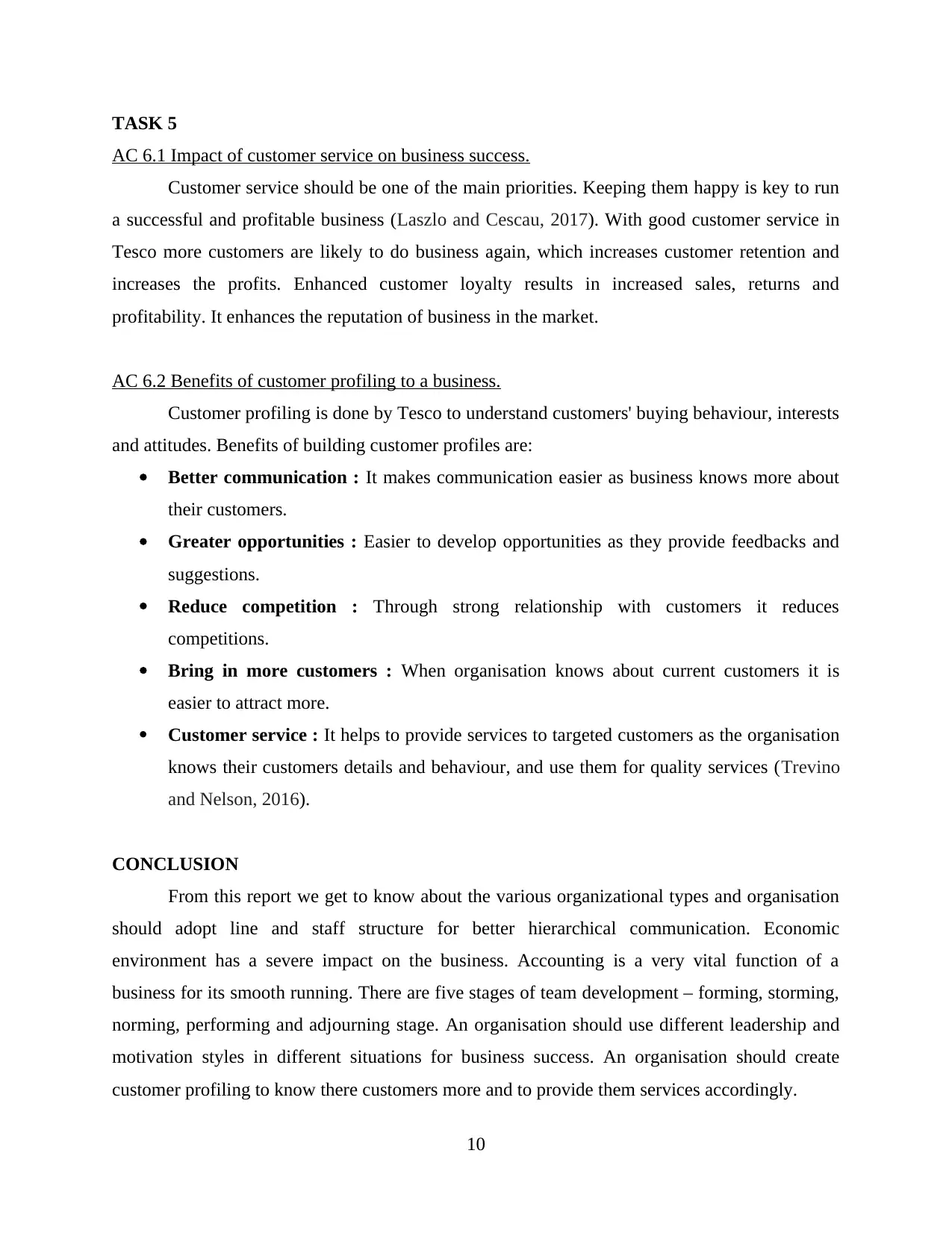
TASK 5
AC 6.1 Impact of customer service on business success.
Customer service should be one of the main priorities. Keeping them happy is key to run
a successful and profitable business (Laszlo and Cescau, 2017). With good customer service in
Tesco more customers are likely to do business again, which increases customer retention and
increases the profits. Enhanced customer loyalty results in increased sales, returns and
profitability. It enhances the reputation of business in the market.
AC 6.2 Benefits of customer profiling to a business.
Customer profiling is done by Tesco to understand customers' buying behaviour, interests
and attitudes. Benefits of building customer profiles are:
Better communication : It makes communication easier as business knows more about
their customers.
Greater opportunities : Easier to develop opportunities as they provide feedbacks and
suggestions.
Reduce competition : Through strong relationship with customers it reduces
competitions.
Bring in more customers : When organisation knows about current customers it is
easier to attract more.
Customer service : It helps to provide services to targeted customers as the organisation
knows their customers details and behaviour, and use them for quality services (Trevino
and Nelson, 2016).
CONCLUSION
From this report we get to know about the various organizational types and organisation
should adopt line and staff structure for better hierarchical communication. Economic
environment has a severe impact on the business. Accounting is a very vital function of a
business for its smooth running. There are five stages of team development – forming, storming,
norming, performing and adjourning stage. An organisation should use different leadership and
motivation styles in different situations for business success. An organisation should create
customer profiling to know there customers more and to provide them services accordingly.
10
AC 6.1 Impact of customer service on business success.
Customer service should be one of the main priorities. Keeping them happy is key to run
a successful and profitable business (Laszlo and Cescau, 2017). With good customer service in
Tesco more customers are likely to do business again, which increases customer retention and
increases the profits. Enhanced customer loyalty results in increased sales, returns and
profitability. It enhances the reputation of business in the market.
AC 6.2 Benefits of customer profiling to a business.
Customer profiling is done by Tesco to understand customers' buying behaviour, interests
and attitudes. Benefits of building customer profiles are:
Better communication : It makes communication easier as business knows more about
their customers.
Greater opportunities : Easier to develop opportunities as they provide feedbacks and
suggestions.
Reduce competition : Through strong relationship with customers it reduces
competitions.
Bring in more customers : When organisation knows about current customers it is
easier to attract more.
Customer service : It helps to provide services to targeted customers as the organisation
knows their customers details and behaviour, and use them for quality services (Trevino
and Nelson, 2016).
CONCLUSION
From this report we get to know about the various organizational types and organisation
should adopt line and staff structure for better hierarchical communication. Economic
environment has a severe impact on the business. Accounting is a very vital function of a
business for its smooth running. There are five stages of team development – forming, storming,
norming, performing and adjourning stage. An organisation should use different leadership and
motivation styles in different situations for business success. An organisation should create
customer profiling to know there customers more and to provide them services accordingly.
10
⊘ This is a preview!⊘
Do you want full access?
Subscribe today to unlock all pages.

Trusted by 1+ million students worldwide
1 out of 13
Related Documents
Your All-in-One AI-Powered Toolkit for Academic Success.
+13062052269
info@desklib.com
Available 24*7 on WhatsApp / Email
![[object Object]](/_next/static/media/star-bottom.7253800d.svg)
Unlock your academic potential
Copyright © 2020–2025 A2Z Services. All Rights Reserved. Developed and managed by ZUCOL.




